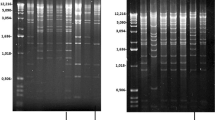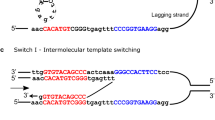Abstract
It is well established that spontaneous cytoplasmic ‘petite’ mutants of Saccharomyces cerevisiae have mitochondrial genome units in which an excised segment of the parental wild-type genome has been tandemly amplified (Fig. 1), so that the excised segment becomes the repeat unit of the petite genome; the latter may in turn undergo further deletions leading to secondary petite genomes having shorter repeat units (see ref. 1 for a brief review). Recent investigations2 on the mitochondrial genomes of several spontaneous petite mutants have shown that frequently the ends of the excised segment correspond to short sequences of the wild-type genome which are extremely rich in GC, the GC clusters; alternatively, they seem to be located in the long AT-rich stretches, the AT spacers, which form at least half of the genome. As sequence repetitions have been demonstrated in both GC clusters and AT spacers2–5, it is very likely that excision takes place by a mechanism involving illegitimate site-specific recombination events between homologous sequences, as previously postulated1. We show here that the sequences involved in the excision of a particular spontaneous petite genome are direct nucleotide repeats located in the AT spacers.
This is a preview of subscription content, access via your institution
Access options
Subscribe to this journal
Receive 51 print issues and online access
$199.00 per year
only $3.90 per issue
Buy this article
- Purchase on Springer Link
- Instant access to full article PDF
Prices may be subject to local taxes which are calculated during checkout
Similar content being viewed by others
References
Bernardi, G. Trends biochem. Sci. 4, 197–201 (1979).
Faugeron-Fonty, G. et al. J. molec. Biol. (in the press).
Cosson, J. & Tzagoloff, A. J. biol. Chem. 254, 42–43 (1979).
Macino, G. & Tzagoloff, A. Proc. natn. Acad. Sci. U.S.A. 76, 131–135 (1979).
Gaillard, C. & Bernardi, G. Molec. gen. Genet. 174, 335–337 (1979).
Sanders, J. P. M., Heyting, C., Verbeet, M. P., Meijlink, F. C. P. W. & Borst, P. Molec. gen. Genet. 157, 239–261 (1977).
Maxam, A. & Gilbert, W. Proc. natn. Acad. Sci. U.S.A. 74, 560–564 (1977).
Calos, M. P., Johnsrud, L. & Miller, J. H. Cell 13, 411–418 (1978).
Grindley, N. D. F. Cell 13, 419–426 (1978).
Prunell, A. & Bernardi, G. J. molec. Biol. 110, 53–74 (1977).
Hensgens, L. A. M., Grivell, L. A., Borst, P. & Bos, J. L. Proc. natn. Acad. Sci. U.S.A. 76, 1663–1667 (1979).
Martin, N. C., Miller, D. & Donelson, J. E. J. supramolec. Struct. Suppl. 3, 132 (1979).
Lewin, A., Morimoto, R., Rabinowitz, M. & Fukuhara, H. Molec. gen. Genet. 163, 257–275 (1978).
Goursot, R., de Zamaroczy, M., Baldacci, G. & Bernardi, G. Molec. gen. Genet. (in the press).
Author information
Authors and Affiliations
Rights and permissions
About this article
Cite this article
Gaillard, C., Strauss, F. & Bernardi, G. Excision sequences in the mitochondrial genome of yeast. Nature 283, 218–220 (1980). https://doi.org/10.1038/283218a0
Received:
Accepted:
Issue Date:
DOI: https://doi.org/10.1038/283218a0
This article is cited by
-
GC clusters and the stability of mitochondrial genomes ofSaccharomyces cerevisiae and related yeasts
Folia Microbiologica (2002)
-
A GC cluster repeat is a hotspot for mit− macro-deletions in yeast mitochondrial DNA
Molecular and General Genetics MGG (1991)
-
Polymorphisms in tandemly repeated sequences ofSaccharomyces cerevisiae mitodhondrial DNA
Journal of Molecular Evolution (1991)
-
A controversy concerning the structure of the mitochondrial genome of a yeast petite mutant: resolution by sequence analysis
Current Genetics (1989)
-
The in vivo effect of acriflavine on mitochondrial functions in the petite negative yeast Hansenula saturnus
Current Genetics (1986)
Comments
By submitting a comment you agree to abide by our Terms and Community Guidelines. If you find something abusive or that does not comply with our terms or guidelines please flag it as inappropriate.



